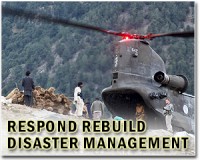| . |  |
. |
Jakarta (AFP) Feb 7, 2010 Despite the desolation wrought by last month's earthquake, Haiti can salvage hope for the future by looking at how the Indonesian province of Aceh rebuilt after the equally devastating 2004 tsunami. From the flattened streets of the capital Port-au-Prince to the death toll of around 200,000, the situation in Haiti bears many similarities to the horrors experienced by Aceh after its quake-triggered catastrophe. The people of Aceh will also recognise the outpouring of international sympathy and aid, and will remember how, like the Haitians now, they wondered whether it would be enough to get their land back on its feet again. More than five years later, it is difficult to imagine that the Acehnese capital Banda Aceh once resembled the shattered ruins of a town razed by war. Many Acehnese even say their lives are better now than before the tsunami, which was launched by a massive undersea quake and slammed into the deeply Islamic province on the northern tip of Sumatra island. "Nothing is perfect but the houses, schools and roads are new and in good condition. Services are also better," said Khairani Arifin, the head of an association for women in Banda Aceh. Perhaps the most significant consequence was a peace pact between the central government in Jakarta and Acehnese separatist rebels, signed in the aftermath of the cataclysm as both sides focused on reconstruction. Despite its chaotic beginnings, when the local authorities were overwhelmed by the influx of foreign aid workers, "the reconstruction of Aceh can be considered a success likely to serve as a model for future disasters of that scale," said Iskandar, who helped coordinate the reconstruction effort. Aid agencies and donors such as the World Bank also learned lessons that will be vital to the rehabilitation of Port-au-Prince, not least the need to sustain and fund the aid effort over the long term. More than 6.7 billion dollars was poured into the rebuilding of Aceh over five years, funding among other things 140,000 new homes, 1,759 schools, 363 bridges and 13 airports. Rod Volway, of Mercy Corps, an NGO still operating in Aceh after most others have completed their missions and gone home, said coordination is "one of the conditions of success". A report released Wednesday by the World Bank, comparing the Aceh response to the current plight of Haiti, pinpointed three key lessons from the Aceh experience: the importance of local leadership; empowering survivors to engage in community-based reconstruction; and coordinating global aid. And of course, speed. "Speed in a post-disaster situation is as important as planning, and to some extent even as important as quality," Wolfgang Fengler, a World Bank specialist who helped Aceh's shattered government respond to the tsunami, said in the report. "Don't get hung up on detailed planning exercises. Help the government come up with a reconstruction strategy, but don't make it too long an exercise or a detailed one. Make it a living document." Local coordination and leadership in Aceh was provided by the Aceh-Nias Reconstruction and Rehabilitation Agency (BBR), which was set up quickly by the Jakarta government to oversee local and international aid work. The BBR wrapped up its operations last year with a deserved sense of pride, even if it sometimes found itself in conflict with international agencies and was accused of being soft on corruption, which is endemic to Indonesia. In the absence of an effective government, as is the case in Haiti, international bodies like the World Bank will have to help keep track of where the money is coming from and how it is being spent, analysts said. "If you have the thousands of projects that Haiti will have, you need to have somebody who tracks them and makes sense of them. Keeping track of them is not through an IT system, it's through people who know how to deal with data," Fengler said. "And that is very important because as you go forward, the government and partners will take many big decisions, especially on where to allocate the money and how to channel it. You need some basis to make these big decisions, and credible data proved crucial in the case of Aceh." Another crucial part of the puzzle is to provide livelihoods as fast as possible to the survivors, aid experts said. "Victims can become development workers, aid recipients can turn into community facilitators and displaced people can rebuild their own future," World Bank vice president Pamela Cox said last month.
Share This Article With Planet Earth
Related Links Bringing Order To A World Of Disasters A world of storm and tempest When the Earth Quakes
 Cockfighting survives Haiti's earthquake devastation
Cockfighting survives Haiti's earthquake devastationPort-Au-Prince (AFP) Feb 6, 2010 The cockfighting must go on, even after earthquakes, so the roosters have been bathed, their claws sharpened, and they wait in cages in the red-carpeted ring, the crowd anxious and gripping cash. The referee has weighed them and announced their names - Doudou versus Zo La Plaine - and now he wants a moment of silence for prayer. Everyone stands, heads bowed. After a couple minutes, the ... read more |
|
| The content herein, unless otherwise known to be public domain, are Copyright 1995-2010 - SpaceDaily. AFP and UPI Wire Stories are copyright Agence France-Presse and United Press International. ESA Portal Reports are copyright European Space Agency. All NASA sourced material is public domain. Additional copyrights may apply in whole or part to other bona fide parties. Advertising does not imply endorsement,agreement or approval of any opinions, statements or information provided by SpaceDaily on any Web page published or hosted by SpaceDaily. Privacy Statement |